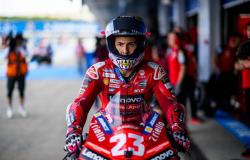The announcement arrived on April 1st, but right from the title – and thanks to the news that had been circulating for weeks – it was immediately clear that it wasn’t the usual fish. The official press release read: “Liberty Media Corporation announces that it has entered into an agreement to acquire Dorna Sports – the exclusive commercial rights holder of the MotoGP world championship – from Bridgepoint and Canada Pension Plan Investment Board. There MotoGP will be attributed to the shares of Liberty Media’s Formula One Group.”
MotoGP, how it will change with Liberty Media
Liberty Media, Dorna and the MotoGP deal
It has been necessary explain the object of the deal to investors, since most of them know little or nothing about two-wheeled competitions, unlike what happens with the very rich US professional leagues, NBA, NFL, MLB and NHL. “MotoGP is the pinnacle of motorcycle racing and offers breathtaking races with top speeds above 360 km/h (223 mph) and lean angles greater than 60 degrees. Since the first season, in 1949, divided over six rounds in Europe, MotoGP has grown significantly and in 2024 it will host 21 races in 17 countries.”. The economic-financial description follows: “The company benefits from an attractive financial profile with diversified and contracted revenue streams, high EBITDA margins and low capital intensity resulting in significant free cash flow”.
The handover concerns the ownership of 86% of the MotoGP shares: 65% paid in cash and 21% through preferred shares (Series C) of Liberty Formula One. The remaining 14% of a company valued at 4.2 billion euros, however, will remain with Dorna’s management. Carmelo Ezpeleta, CEO of Dorna since 1994, will continue to manage the company which retains its headquarters in Madridjust as Enrique Aldama will still be COO and CFO, Dan Rossomondo commercial director and Carlos Ezpeleta sports director.
A few hours later, Dorna’s number one held a conference call with investors, together with Greg Maffei, president and CEO of Liberty Media. After the latter’s introduction, he took the floor Ezpeleta: “We are incredibly happy to announce this partnership and look forward to this new step in the evolution of MotoGP”. Using a series of slides, the seventy-seven-year-old Catalan manager underlined how MotoGP (which at the time did not exist with this name or with these classes) was the first world motorsport championship, anticipating Formula 1, born in 1950, by a year. : “In 1992 Dorna took over the MotoGP rights from the International Motorcycle Federation. Since then we have worked together to develop the best motorcycle racing championship in the World. Since 1992 we have extended our exclusive agreement with the FIM six times.”. Ezpeleta then traced the profile of the MotoGP actors: “We have 11 strong teams with two drivers each. Pilots are incredible athletes, strong, skilled and courageous. This is a great attraction for our fans.”. Given the modest results obtained in the last two years by some teams, in particular those branded Honda, that of 11 strong teams at the moment is a splendid lie, but the innkeeper cannot be expected to be objective about the quality of the wine he serves. Then Ezpeleta underlined the presence of five manufacturers and explained that the six independent teams can choose who to rent the bikes from, also thanks to the spending limits set by Dorna for the rental: “This creates a healthy ecosystem and strong competition. Every team has won a race in the last four seasons… Last year we had 15 drivers on the podium and eight different winners from six teams. The average gap between the winner and the second place in the GPs and Sprints was less than a second and this year we have already had eight drivers from six different teams on the podium.”
The idea of highlighting competitive balance should have struck a chord with Americans, who have always been supporters of mechanisms useful for avoiding monopolies that make the dispute predictable: an example of this is the draft that allows the last-placed teams in a championship to pick the best players available for the following year, as well as the salary cap, i.e. the salary cap. The MotoGP boss focused on the follow-up to the championship, listing the three million spectators on the circuit in 2023, the audience of 140 million people on digital channels, including 50 million on its own social media, up from 30 million from two years ago. Next, he clarified the direction that the calendars will take in the coming years: “This year we have a big European presence but we are a global sport. The success achieved in Southeast Asia is a guide to growing the sport in South America too. The USA is another opportunity, with a lot of history in the sport, and where riding motorcycles is culturally important. Liberty clearly has a lot of experience in the US market from which we will benefit”. In twelve minutes of monologue Ezpeleta did not mention Moto2 and Moto3 even once, preferring instead to underline Dorna’s investment in accessibility and inclusion through the platform “Road to MotoGP”the creation of programs for young riders around the globe and the launch of the Women’s World Championship.
Maffei: “We will not deal with MotoGP and F1 together”
Taking the floor again, Maffei presented the sources of revenue of MotoGP, in particular the television contracts, letting slip that “Twenty-two GPs a year is the correct number and we will try to focus on having a mix of races across the planet”. The sixty-three-year-old of clear Italian origins then faced the barrage of questions from investment groups: “We will not cover F1 and MotoGP togethernegotiating them as a single package, due to the rules and structure of our agreements with Formula 1 teams.” he said, in a clear reference to TV rights. The attention of those present focused on the sums that Dorna pays to the various teams and here Carlos Ezpeleta spoke: “The amounts depend on the number of GPs in the season, there is one payment for the events in which the teams participate and another for the entire championship. The sums are fixed, they do not depend on the income generated by Dorna. We managed to keep costs under control: an independent team spends 15 million euros a year, half of which is covered by Dorna”. Maffei rejected the idea of organizing a GP on the streets of Las Vegas, or on other city circuitsas Formula 1 did instead, and added: “This is an incredible product, we have no plans to change this sport, which has a great fan base, as well as incredible competition and pathos. Our hope is to broaden the audience and increase the number of commercial partners, these things will go hand in hand.”
The unknown of the approval of the entire operation remains. To obtain it, Renee Wilm, chief legal officer of Liberty Media, explained that “An application will be submitted to the European Union and other applications to the antitrust authorities of the United Kingdom, Brazil and Australia. Secondly, applications will be made to Spain and Italy for FDI (Foreign direct investment, nde). I think that the Antitrust authorization should arrive by the end of the year, before the end of the fourth quarter”. The die is cast and Austin, coincidentally in the States, was in fact the first weekend of the new era.
MotoGP calendar
Tags: MotoGP wake distorting nature






